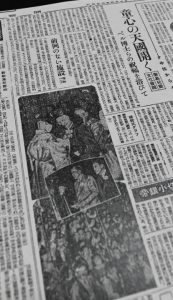Striving to fill voids in Hiroshima, Chugoku Shimbun and the press code — Surveillance of articles with A-bombing content, Part 9: Measures to avoid criticism of bombings
Sep. 30, 2023
CIE strove to re-educate Japanese “correctly”
The Allied occupation of Japan, led by the General Headquarters of the Allied Powers (GHQ), had the major objective of reforming Japan from a militaristic nation to a democracy through such initiatives as the Humanity Declaration issued by the emperor, the promulgation of a new constitution, labor reforms, agricultural reforms, and the dissolution of what were known as “zaibatsu” business conglomerates. Press-code based censorship included an aspect of promoting occupation policies while maintaining public safety and security. The Civil Censorship Detachment (CCD) was tasked with the actual work of carrying out censorship policies.
The Civil Information and Education Section (CIE), another organization within the GHQ, had the aim of re-educating the Japanese people. That group was responsible for such activities as radio broadcasting that looked back at the war from the viewpoint of the GHQ.
Instilling sense of guilt
The plan symbolic of the CIE’s work was known as the “War Guilt Information Program” (designed to instill feelings of culpability about the war in the hearts and minds of the Japanese people). The literary critic Jun Eto (1932–1999) set out to reveal details of the program by investigating enormous amounts of materials in Japan and the United States in his book Tozasareta Genron Kukan: Senryo-gun no Kenetsu to Sengo Nihon (in English, ‘No room for speech: Censorship by occupation forces and post-war Japan’), which was released in 1989, and other publications.
What specifically did the CIE do? Mr. Eto focused on a CIE document dated February 6, 1948, because it contained a certain recommendation.
The document was produced right before the final and closing arguments were made at the International Military Tribunal for the Far East (Tokyo Trial). Hideki Tojo, former prime minister of Japan and one of the defendants in the public trial, explained his ultra-nationalistic views to justify Japan’s invasion of other countries. Moreover, a group of journalists ramped up their criticism of the atomic bombings of Hiroshima and Nagasaki, calling them an atrocity. The recommendation in question emphasized that “new measures” were necessary to respond to that situation.
According to Mr. Eto’s written work, one of the proposed measures for dealing with criticism of the U.S. atomic bombings was to dispatch a CIE representative to an “A-bomb monument dedication ceremony” scheduled to be held in Hiroshima in April 1948. It called for guidance designed to ensure that the Japanese news media would interpret the event “correctly…”
Nevertheless, as far as can be discerned from the pages of the Chugoku Shimbun published in April of that year, verification is not possible regarding whether a dedication ceremony was ever conducted. In his writings, Mr. Eto also did not touch on the holding of any such ceremony.
In the Chugoku Shimbun newspapers published during that period, an event that might have been the equivalent of the ceremony was mentioned in the May 3 edition. That event was the opening ceremony of the Hiroshima Children’s Culture Hall, built in the area of Motomachi in Hiroshima City (in the city’s present-day Naka Ward). Dr. Howard Bell (1897–1960), an advisor at the CIE, attended the ceremony as a guest. The live ceremony was broadcast by radio nationwide.
The Chugoku Shimbun published the following day, May 4, covered the ceremony extensively with the headline “Childhood heaven opens with blessings from Dr. Bell and others.” Three photographs accompanied the article, including a photo of Mr. Bell making congratulatory remarks.
Exchange and other events held to ward off criticism
Mr. Bell paid a visit to the Chugoku Shimbun’s head office on May 6. However, the newspaper had a simple report of his visit on May 7, the following day, using the language, “He had a meeting with Chugoku Shimbun’s executives and toured its office.” From the article, it is difficult to interpret whether Mr. Bell had provided guidance to the executives during the visit to ensure that the newspaper would interpret the event “correctly.”
Mr. Bell had visited Hiroshima several times since January 1947. He repeatedly met with children at Honkawa Elementary School (in Hiroshima’s present-day Naka Ward), presenting them with stationery and children’s books. In May 1949, he donated around 1,500 copies of picture books and other publications, which are now archived in what is known as the “Bell Collection” at the Hiroshima City Children’s Library (Motomachi, Naka Ward).
Such exchanges can be considered to be part of CIE’s “Measures for Hiroshima.”
(Originally published on September 30, 2023)








